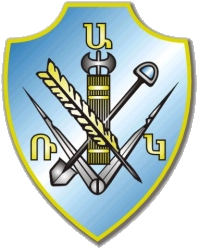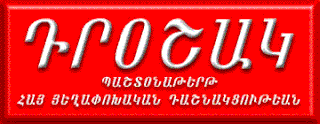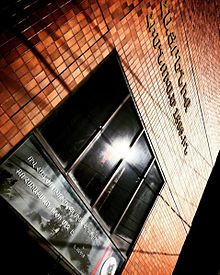
Watertown is a city in Middlesex County, Massachusetts, United States, part of Greater Boston. The population was 35,329 in the 2020 census. Its neighborhoods include Bemis, Coolidge Square, East Watertown, Watertown Square, and the West End.
James Martin Fenton is an English poet, journalist and literary critic. He is a former Oxford Professor of Poetry.

The Armenian Democratic Liberal Party, the Ramgavar Party,, also known by its Armenian initials or its English initials ADL is an Armenian political party in the Armenian diaspora including the Middle East, Europe, the Americas and Australia.
Haroutioun Hovanes "H.H." Chakmakjian was a published scientist, as well as the father of American composer Alan Hovhaness. A professor of chemistry at Tufts University, Chakmakjian wrote numerous books in several languages. His notable publications included an English-Armenian dictionary which is believed to be the first of its kind in the modern Armenian language. The dictionary has become an enduring work of Armenian lexicography and remains regularly used today. His other publications included a 700-page history of Armenia.

The Armenian Youth Federation (AYF) is the youth organization of the Armenian Revolutionary Federation. Founded in 1933, the AYF became a global Armenian organization and stands on five pillars that guide its activities: Educational, Hai Tahd, Social, Athletic and Cultural. Moreover, the AYF promotes social democratic values and a fraternal attitude of respect for ideas and individuals amongst its membership. Unity and cooperation are essential traits that allow members of the organization to work together to realize the AYF's objectives. The AYF is a full member of International Union of Socialist Youth and Young European Socialists.

Shahan Natalie was an Armenian writer and political activist who was the principal organizer of Operation Nemesis, a campaign of revenge against officials of the former Ottoman Empire who organized the Armenian genocide during World War I. Originally a member of the Armenian Revolutionary Federation, he later left the party over disagreements regarding its policy towards Turkey. Of his writings on Armenian national philosophy, his essay The Turks and Us is the best known. The main argument of Natalie's writings is that it is impossible for Armenians to come to any kind of understanding with Turks, whom he considered the chief enemy of Armenians, let alone cooperate with Turkey against the Soviet Union.
Horizon Weekly is an Armenian Canadian newspaper publication and is the official political newspaper of the Armenian Revolutionary Federation (ARF)'s Canadian Central Committee.

Droshak is the official organ of the Armenian Revolutionary Federation (ARF) published in Tiflis (1890), Balkans (1890s), Geneva (1892-1914), Paris (1925–33), Beirut (1969–85), Athens (1986-96), Yerevan. It was first published in 1890 by ARF founder Christapor Mikaelian as a monthly, then as a bi-monthly, bi-weekly, and weekly. Initially published as an illegal newspaper in Tiflis (Tbilisi) in the Russian Empire, it was established as a legal publication in Geneva in 1892, where it continued to be published until 1914, when publication was ended due to the start of the First World War. Its primary subject was the ideological questions of the party and the Armenian national liberation movement. It resumed publication in Paris in 1925 until ending again in 1933. During this period, the paper dealt with political and ideological questions regarding the situation in Soviet Armenia and debates between communism and socialism. It was reestablished as a weekly in Beirut in 1969 and was moved to Athens in 1986 after the kidnapping of its editor Sarkis Zeitlian. Droshak's editorial board returned to Lebanon in 1996, but publication continued in Athens. After officially registering Droshak in Armenia in 1999, the editorial board and publication moved to Yerevan. Since then, it has been released in print on a quarterly basis and makes weekly electronic publications.

Ruben Ter Minasian was an Armenian politician and revolutionary of the Armenian Revolutionary Federation (ARF) who played an important role in the Armenian national liberation movement and later in the First Republic of Armenia.

The Armenian Mirror-Spectator is a weekly newspaper published by the Baikar Association in Watertown, Massachusetts. It was founded in 1931 as The Armenian Mirror, later merging with another Armenian-American newspaper, The Spectator, in 1939. It is the official English-language organ of the Armenian Democratic Liberal (Ramgavar) Party in the United States.
Armenian newspapers are published in Armenia and in the Armenian diaspora where there are concentrations of Armenians.

Hairenik is an Armenian language weekly newspaper published by the Hairenik Association in Watertown, Massachusetts, United States. The newspaper belongs to the Armenian political party – Armenian Revolutionary Federation (ARF). The newspaper reflects the views and opinions of ARF as well as Armenian diaspora organizations – ANCAs.
Hairenik Weekly may refer to one of two publications both published by Hairenik Association in Watertown, Massachusetts:

Baikar is an Armenian language weekly published by the Baikar Association Inc., in Watertown, Massachusetts, United States.

Hairenik Association is a publishing house fully owned and operated by the Armenian Revolutionary Federation located in Watertown, Massachusetts, United States.

Ardashes Hovsepian better known by his penname Malkhas was an Armenian writer and revolutionary, best known for his four-volume novel Awakening (Zartonk).

Sarkis Minassian (1873–1915), also known as Aram Ashod, was an Armenian journalist, writer, political activist, and educator. He became the chief editor of the newspaper Hairenik in Watertown, Massachusetts. After returning to the Ottoman Empire in 1909, Minassian continued writing in various journals in the city. In 1915, Sarkis Minassian was killed during the Armenian genocide.

Diana Der Hovanessian, Armenian American poet, translator, and author. Much of the subject of her poetry was about Armenia and the Armenian diaspora. She wrote and published over twenty-five books.

Artashes Stepani Chilingarian, better known as Ruben Darbinian, was an Armenian politician, activist and writer. He was a member of the Armenian Revolutionary Federation (ARF) political party. In 1920, he served as the minister of justice of the First Republic of Armenia. He was also a renowned contributor to and editor of a number of Armenian publications in Tbilisi, Baku, and Boston.

Perchuhi Partizpanyan-Barseghyan was an Armenian pedagogue, writer and humanitarian worker. She was one of the first three women elected to serve as a member of the parliament with the formation of the First Republic of Armenia in 1919. After the fall of the republic, she briefly relocated to Bulgaria, before continuing her literary career in Paris. She received recognition for her short stories from the American anthologist, Edward J. O'Brien. She worked in the Nansen International Office for Refugees in Paris trying to assist Armenians who had been affected by the Armenian genocide.















